Did you know that up to 98% of your website visitors leave without saying a word?
- No signups.
- No form submissions.
- No trace of who they are, just an anonymous blip in your traffic analytics.
Leaving this going with the flow is not the wisest decision, considering that behind every unrecognized session could be a high-intent decision-maker, a ready-to-buy account, or your next big client.
If you’ve ever found yourself asking, “Who is visiting my website?”, learning how to turn that anonymous traffic into qualified B2B leads will have the most positive impact on your business.
Why You Should Track Who Visits Your Website
You spend time and money bringing traffic to your site through ads, content, SEO, and email campaigns. But do you know what happens after people click on your links? This is where data analytics in digital marketing becomes essential, helping you understand user behavior, engagement paths, and conversion triggers that reveal who’s truly interested.
Researchers from Gartner have found that only 17% of the buyer’s journey involves direct interaction with suppliers. Most people prefer researching on their own, either online, offline, or through other means.
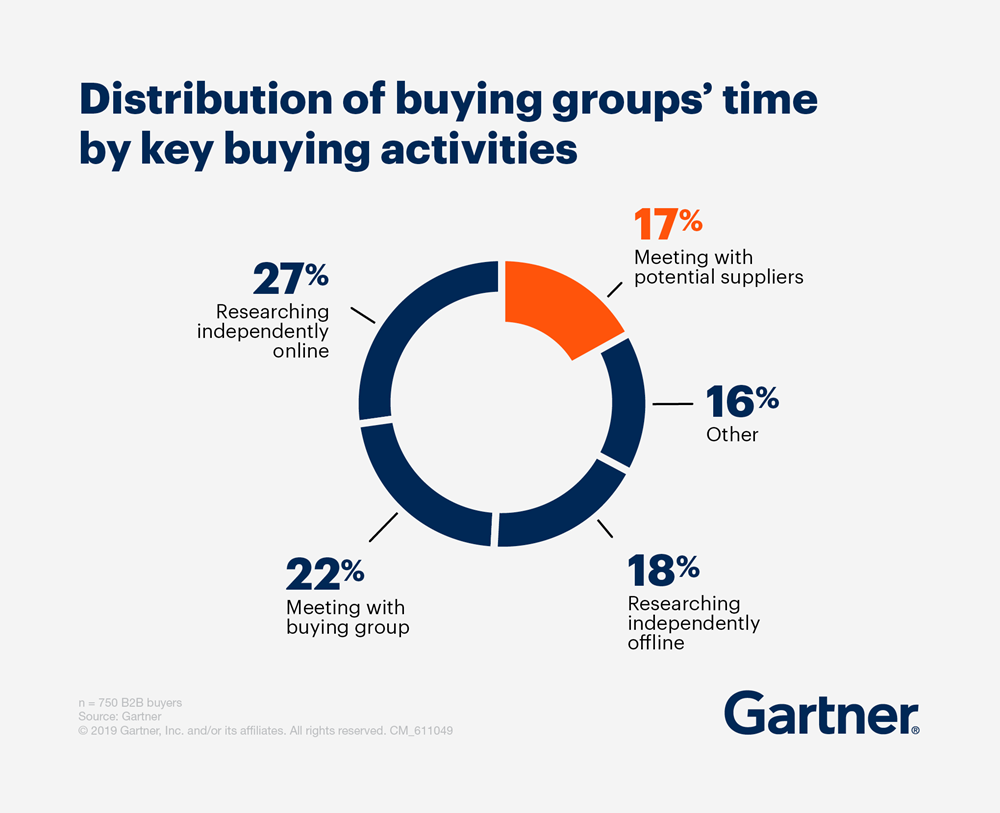
This means that most of your B2B leads search on their own, quietly gathering insights and comparing offers from other competitors before contacting you.
In this passive stage, every anonymous visit is a potential lead evaluating your solution without saying a word. That’s why simply relying on contact forms or demo requests isn’t enough anymore. Businesses need a reliable strategy to track those visits and understand the reasons they choose to stay behind.
Here’s what identifying those silent visitors can help you achieve:
- Capture High-Intent B2B Prospects: Not all traffic is equal. Someone browsing your pricing or solutions page is miles ahead in the buyer journey compared to a blog reader. Knowing who’s looking at what helps your sales team prioritize outreach.
- Fuel Smarter Lead Generation: When you identify B2B website visitors, you no longer start from scratch. Instead of cold outreach, you are now dealing with people who already know your brand, so they are somewhere in the engagement stage of your customer journey.
- Maximize Marketing ROI: Tracking your silent visitors helps tie website traffic back to pipeline impact. Instead of vague traffic metrics, you’ll get actionable signals on what content drives real engagement from target accounts.
Can You Really See Who Visits Your Website?
Short answer: not exactly, but there’s more nuance.
When people search for how to see who visited your website, they often imagine getting full names, email addresses, and job titles handed over on a silver platter. But due to privacy laws and the way the internet works, that’s not how it goes.
Here’s what you can see with the right tools:
- Company names and industries associated with the visitor’s IP address
- Geographic location (country, city, sometimes even region or ISP)
- Pageviews and session behavior, like time on page, scroll depth, or conversion paths
- Traffic sources (e.g., email, social, organic, referral)
- Device type and browser info
And here’s what you can’t see:
- Individual names or contact information (unless they submit a form)
- Exact actions of one specific person (you see sessions, not identities)
- Personal behavioral traits tied to real-world individuals (this would violate major data privacy laws)
What’s the deal with those limitations?
Because the vast majority of web users are anonymous by design. Unless they voluntarily share information through a form, a login, or tracking permission, there’s no legal or technical way to access personal data.
Legal and Ethical Considerations You Can’t Ignore
If your goal is to identify B2B website visitors, compliance isn’t optional, but critical. Any attempt to track or profile users must align with data protection regulations like:
- GDPR (General Data Protection Regulation) in the EU
- CCPA (California Consumer Privacy Act) in the US
- Other regional laws with strict cookie consent and data handling rules
You’ll need:
- Transparent cookie banners and consent mechanisms
- A privacy policy that clearly explains data usage
- Tools that comply with current legislation (most top-tier B2B tracking platforms do)
While you can’t identify individuals, you can identify companies, and that insight alone can transform how you approach lead generation and sales strategy.
Common Misconceptions About Tracking Website Visitors
When marketers start asking, “Who is visiting my website?”, they often run into a few common myths, fueled by outdated information and unrealistic expectations.
Google Analytics and Other Analytics Platforms
First, there’s the belief that tools like Google Analytics can tell you who is visiting your website. While it’s a powerful platform, it is mainly used to analyze behavioral patterns and not to identify visitors. It can show you traffic sources, bounce rates, average session duration, and which channels drive the most engagement, but not the names of companies or people browsing your content.
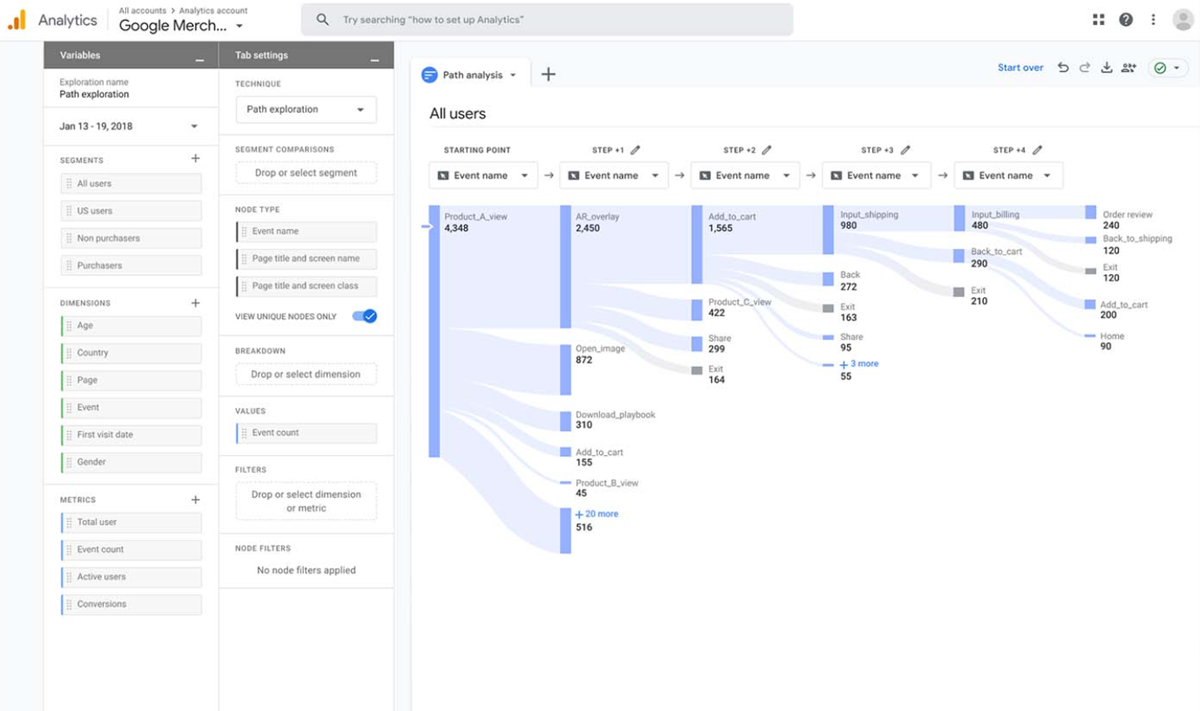
Even with enhanced funnel tracking or goal conversions, you’re still operating in the dark when it comes to identifying actual B2B prospects. It’s great for optimization and UX decisions, but not for building a lead list.
Beyond Google Analytics, other behavior analytics tools like Microsoft Clarity, Hotjar, or Smartlook can provide valuable qualitative insights by visualizing user sessions, heatmaps, and click patterns. These tools don’t identify who the visitor is but show how users interact with your site — where they scroll, what captures attention, and where they drop off. When combined with GA’s quantitative metrics, they help marketers understand why users behave a certain way, even if their identities remain anonymous.
Reverse IP Lookup Tools
Another common approach is using reverse IP lookup tools. The idea here is that you can identify companies based on their IP addresses. That’s true in theory. These tools match the IPs of your site visitors to a known database of corporate networks.
The reality, however, is more complex. Most Internet users use dynamic or shared IP addresses, meaning their data becomes incomplete or inconsistent. Plus, if your site isn’t already collecting visitor IPs, there’s nothing for these tools to match in the first place.
There are also important legal and ethical guardrails. IP-based tracking must still comply with GDPR and CCPA requirements. Users may come from regions with strict data laws, so you’ll need their explicit consent to track any personal data.
How to Identify B2B Website Visitors
It’s one thing to ask “Who is visiting my website?” and another to actually uncover useful answers.
Luckily, thanks to modern tools and data enrichment platforms, identifying anonymous website visitors is more achievable than ever, especially for B2B companies.
While most B2B buyers begin their journey with anonymous research, often visiting vendor websites multiple times before ever filling out a form, businesses get a massive window of opportunity if they know how to spot it.
Here are the key approaches that work in 2025:
- Use B2B visitor identification tools to reveal company names from anonymous traffic.
- Integrate CRM and marketing automation to sync visitor behavior with known leads and nurture returning traffic.
- Use gated content and forms to encourage self-identification in exchange for value-driven resources.
- Monitor forms in real time to catch failed submissions and recover leads you didn’t even know you lost.
Let’s walk through each of these strategies, studying how they work, where they shine, and how to choose the right combination for your business.
Dedicated B2B Visitor Identification Tools
When it comes to finding out who’s behind your website traffic, dedicated visitor identification tools do most of the heavy lifting. These platforms go beyond standard analytics by using tracking scripts and proprietary databases to match anonymous sessions with real company-level data.
Once installed on your website (usually with a lightweight script), these tools monitor incoming traffic and collect data like IP addresses, browsing behavior, page visits, and session duration. The real magic happens in the background, where they cross-reference that data with their own business databases to identify which companies are visiting your site. Instead of just showing you traffic numbers, they show you which businesses are exploring your services, what content they engage with, and how often they return.
And because these tools focus on company-level insights and not individual users, they typically remain compliant with GDPR and other privacy regulations when used responsibly.
Some of the top platforms in this space include:
1. Leadfeeder
Leadfeeder connects with your existing Google Analytics setup to surface company-level data from your traffic. It identifies the businesses browsing your site and ranks them by engagement so you can prioritize outreach.
Standout Features
- Connects directly to Google Analytics for seamless setup
- Scores visitors by session duration, page depth, and frequency
- Syncs with CRMs like HubSpot, Salesforce, and Pipedrive
Pricing
Starts at €99 per month / billed annually
2. Lead Forensics
Lead Forensics is a real-time tracking tool that reveals the companies visiting your website, even if they don’t fill out a form. It provides contact suggestions, visit frequency, and deep behavioral data to fuel sales conversations.
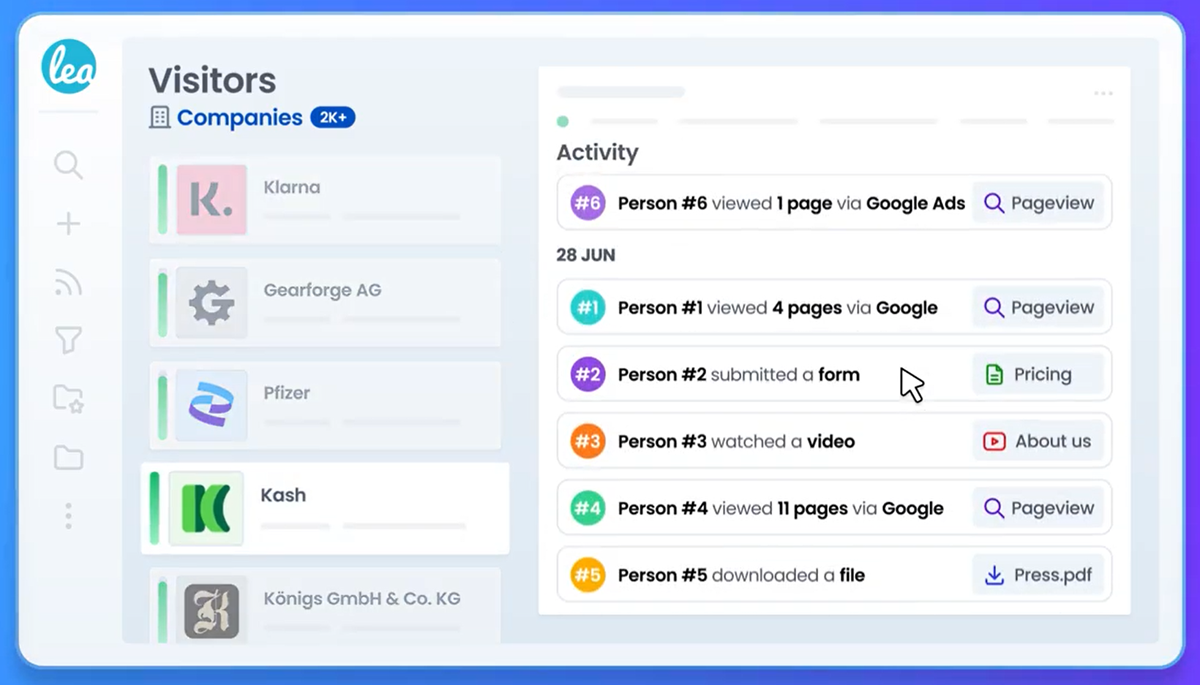
Standout Features
- Provides in-depth insights into visit behavior
- Trigger reports and conversion tracking
- Integrates with leading CRMs
Pricing
Custom pricing, available upon request
3. Visitor Queue
Visitor Queue identifies which companies are visiting and provides key contact recommendations within those businesses, making it easier to find the right person to connect with based on job role or seniority.
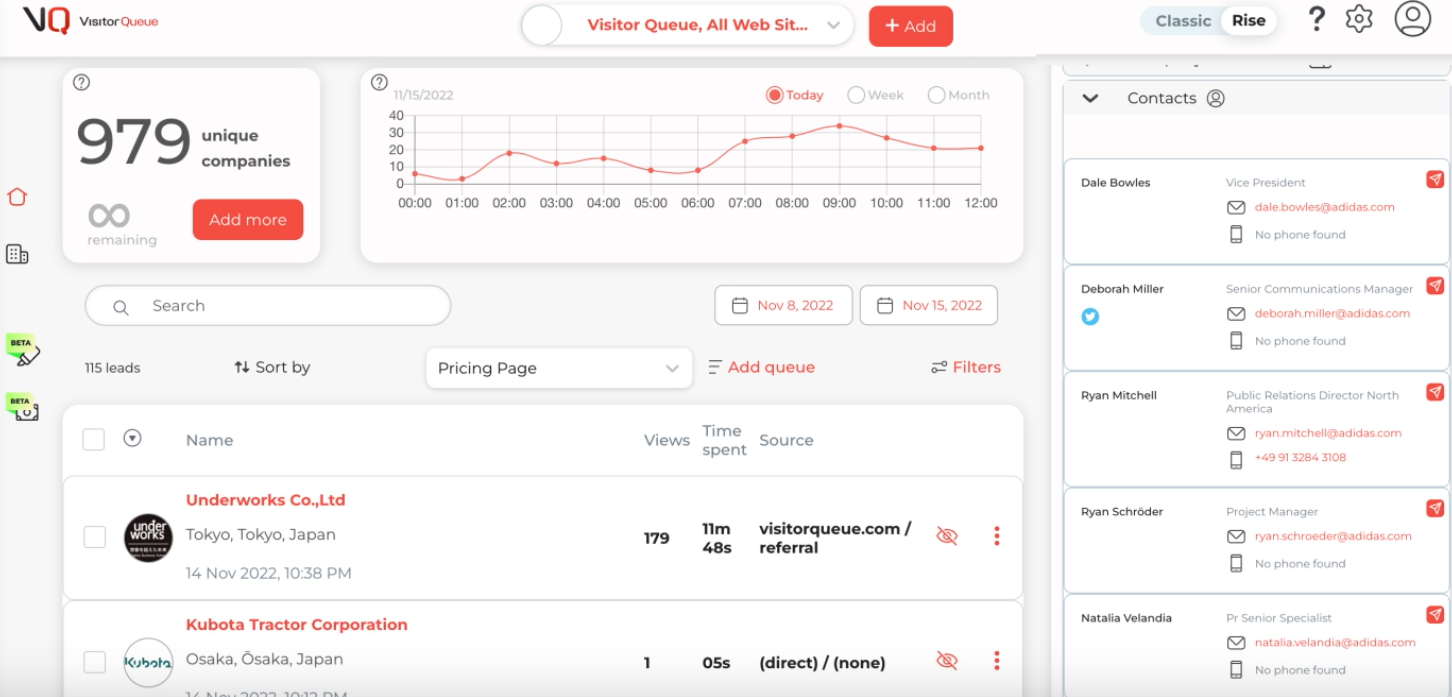
Standout Features
- Identifies the company name, location, and industry from traffic
- Provides anonymous website visitor tracking
- B2B website personalization tools
Pricing
Starts at $31 per month / paid annually
4. Apollo.io
While known for outbound prospecting, Apollo.io also allows you to enrich website visitor data with firmographics and contact info. It’s especially useful for combining visitor identification with proactive outreach.
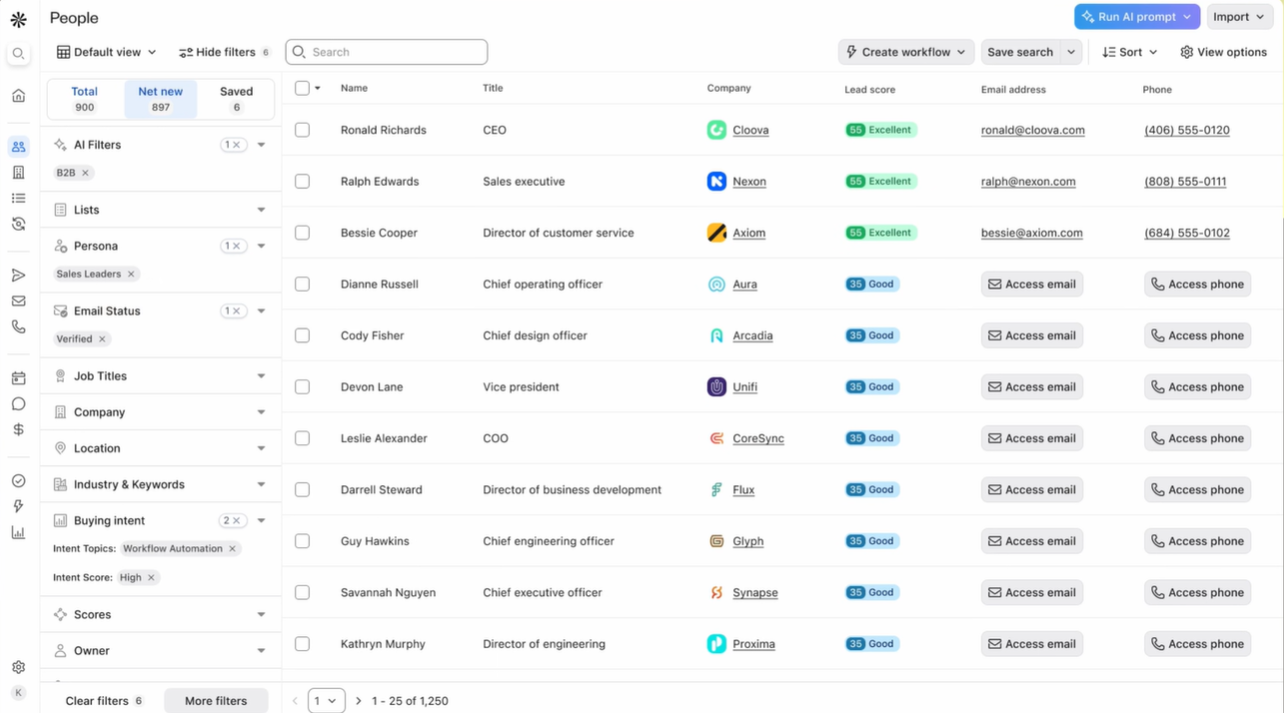
Standout Features
- Access to over 275M+ verified contacts across industries
- Automated outreach workflows (email, dialer, LinkedIn)
- Advanced integrations with CRM databases
Pricing
Starts at $49 per user / per month / billed annually
CRM & Marketing Automation Integrations
Visitor identification tools help you find out who’s exploring your website, while CRM and marketing automation are there to connect the dots. Such tools can track how leads from your actual pipeline interact with the website in real time. If a prospect has previously downloaded a case study and now returns to view your pricing landing page, that behavioral data is automatically tied to their contact record.
This kind of insight helps sales and marketing teams stay aligned and respond at the right moment, with the right message.
CRMs also make it easier to:
- Score leads based on website engagement
- Trigger automated email sequences or retargeting workflows
- Track how marketing touchpoints contribute to closed deals
Using Website Forms and Gated Content
Not everyone is ready to speak to your sales team right away, so having website forms and gated content can help you get their contact information.
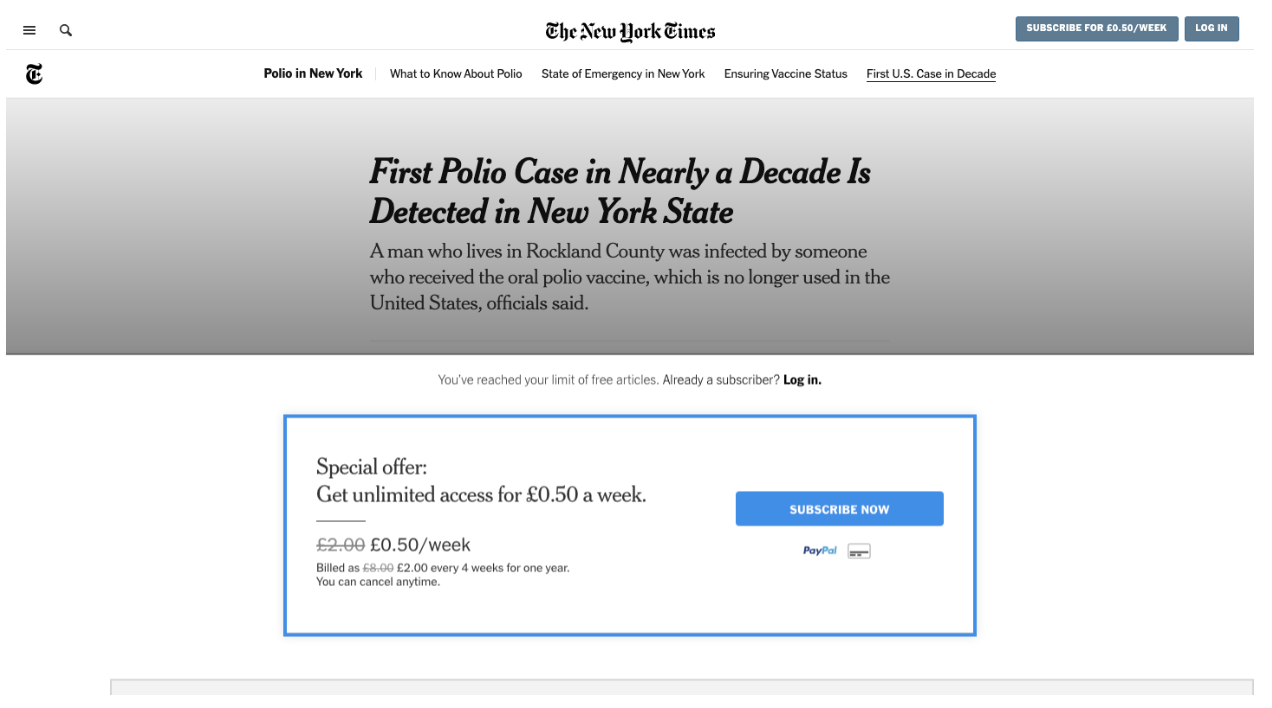
Think of gated content as a two-way street: you provide something useful (like a whitepaper, case study, or pricing access), and in return, visitors voluntarily share their details. This creates a natural opportunity for self-identification without adding pressure or friction to the experience.
A few examples of high-performing gated assets in B2B marketing include:
- Industry-specific whitepapers or research reports
- ROI calculators or templates
- Webinars or on-demand demos
- Early access to pricing or product roadmaps
Recover Missed Leads with Real-Time Form Monitoring
Here’s a problem most businesses never see coming: their web forms are broken, and no one knows.
Whether it’s a misfired validation, a script error, or a mobile compatibility glitch, forms can quietly fail behind the scenes. And when they do, potential leads vanish without a trace. No alert. No email. Just a lost opportunity that never makes it into your CRM.
Even when forms don’t fail entirely, many users abandon them halfway, especially if they’re too long, confusing, or slow to load.
Tools like FormStory can help you monitor every form on your site in real time, detecting submission errors and capturing all entered data, even if the visitor doesn’t hit “submit.” The software sends instant alerts when a form breaks, ensuring your team can fix issues before they cost you leads.
For B2B teams investing in paid traffic, content, or SEO, this kind of monitoring is non-negotiable. It’s all about collecting more leads and ensuring you don’t lose the ones who already showed intent.
Best Practices for Tracking B2B Website Visitors
Tracking website visitors is a strategic process requiring the right mix of tools, compliance, and prioritization to be effective and sustainable.
Below are some practical tips that help businesses get the most value from their B2B visitor data.
1. Use a Combination of Tools for Accuracy and Coverage
No single tool can give you the full picture. Knowing how to pair multiple data points, like IP addresses and browser behavior, with your CRM records can have incredible results.
For example, you might use a tool like Leadfeeder or LeadForensics for initial company identification, then sync that data with HubSpot or Salesforce to tie it back to known contacts. On top of that, retargeting platforms (like LinkedIn Ads or Google Ads) can be layered in to re-engage visitors who didn’t convert.
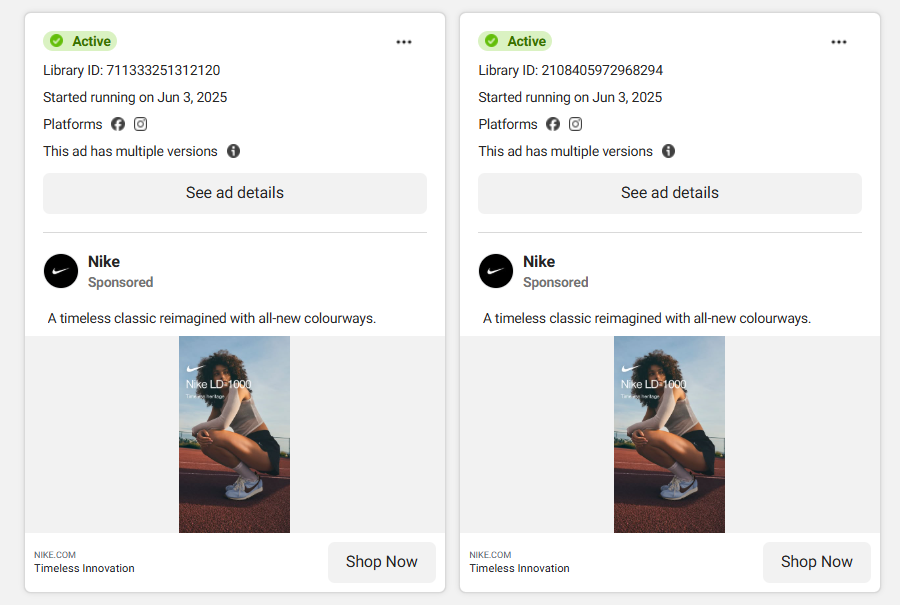
This multi-tool strategy helps you:
- Cross-validate visitor identities across platforms
- Track both anonymous and known users throughout their journey
- Align marketing insights with sales actions in near real time
2. Ensure GDPR and CCPA Compliance
Even when you’re only identifying companies instead of individuals, many tracking methods (such as cookies or IP logging) fall under these two key regulations.
To stay compliant:
- Implement clear cookie consent banners that allow users to opt in or out
- Disclose all tracking and data usage in your privacy policy
- Ensure your tools anonymize or mask personal data where required
- Store data securely and only for as long as necessary
Some tools, like Apollo.io and Leadfeeder, offer features specifically designed to comply with global data privacy laws; ensure to activate them during setup.
Technical compliance may also involve setting cookie lifetimes, respecting “Do Not Track” browser signals, or selectively disabling scripts for users in restricted regions.
3. Prioritize High-Value Accounts for Sales Follow-Ups
Once you’ve identified who’s visiting your website, not every visitor deserves the same level of attention. B2B sales cycles are long and resource-intensive, which makes prioritization critical. Plus, not everyone will come from the same funnel, so knowing how to speak to each lead can cost you extra effort and nerves.
Integrations with CRMs make it easier to:
- Tag high-intent companies and route them to sales reps
- Trigger tailored email sequences or LinkedIn outreach
- Suppress low-quality traffic from automated campaigns
Over time, this prioritization not only improves conversion rates but also helps align your sales and marketing teams around a shared, data-backed strategy.
Turning Anonymous Visitors into Qualified Leads
Identifying silent visitors is only half the equation. Your end goal is to take the insights from all the tools and turn that data into action by converting the passive interest into active engagement. There are a couple of effective ways to do that:
Retargeting Ads
Digital advertising allows you to serve highly specific retargeting ads to users who have already visited your key pages, like pricing, product overviews, or demo requests. This keeps your brand top-of-mind and gently nudges decision-makers back into your funnel. Integrating it with broader digital marketing services ensures consistent messaging and measurable growth across all channels.
Personalized Email Outreach
If your CRM is synced with visitor activity, your team can develop hyper-relevant email marketing campaigns to reach out to these people. For example: “We noticed your team explored our pricing page. Happy to walk you through the best-fit option.” These contextual touches convert far better than cold intros.
Dynamic Website Content for Returning Visitors
With the right tech stack, your website can adapt its content based on who’s visiting. Returning prospects might see personalized CTAs, industry-specific testimonials, or product highlights that align with their past behavior, creating a seamless, tailored experience.
Measuring success and refining your approach
The final (but ongoing) piece of the puzzle is analysis. Use data analytics platforms to monitor engagement trends, content performance, and lead quality. Over time, these insights help you refine your outreach strategies and double down on what works.
Most B2B websites are filled with missed opportunities, not because of a lack of traffic, but because so much of that traffic goes unidentified and unconverted.
If you’ve ever asked “Who is visiting my website?”, you’re already on the right track. The next step is to build a system that not only tracks this activity but also transforms it into leads, conversations, and revenue.
At Andava Digital, we help businesses do exactly that. From choosing the right website visitor tracking tools to building GDPR-compliant funnels, syncing CRMs, and launching smart retargeting campaigns, we bring all the pieces together.